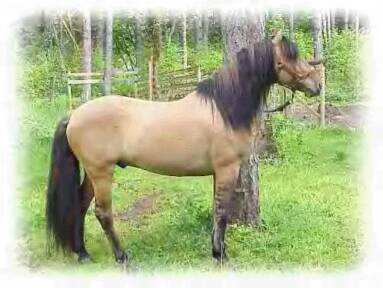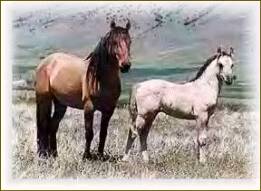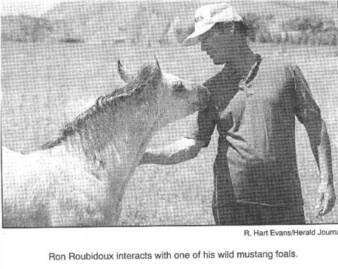The importance of Type in Spanish Mustangs
D. Phillip Sponenberg, DVM, PhD
"Type" is a difficult concept to define, but is an absolutely vital one when talking about breeds of livestock. One definition of type is the conformational peculiarities that separate one breed from another. It is safe to add that "type" almost represents the ideal mental picture of a breed. Type is therefore central to a breed's character and identity, and it is what sets the different breeds apart one from another. Quarter Horses have a "type"; Spanish Mustangs a different "type". Even closely related breeds, such as the Peruvian Paso and the Spanish Mustang, have subtle differences in type that help distinguish one from the other.
The Spanish Mustang comes to us today as an interesting amalgam of feral, rancher, Indian, Mission, and Mexican strains. One result of this broad base is that there are different types within the Spanish Mustang breed. These are described in breed literature as a heavy and a lighter type, with many intermediates. Within the extremes in the breed there are some consistent conformational traits that set Spanish Mustangs off from other horses, and these conformational traits are essential to the true type of the Spanish Mustang. Horses that exhibit all of the conformational peculiarities of the breed are said to be "of better type" than those that have fewer.
Breeders of any breed need to be aware of type and what it is. Within every breed some individuals are going to be born that are "off type". The fate of these individuals has an important impact on the fate of the breed. If these animals are heralded and used widely as breeding stock, the breed's type will slowly erode until the original breed is unrecognizable. If, on the other hand, "off type" individuals are culled from breeding, then the original type can be preserved.
Modern horse breeds in America can give good lessons in the importance of type, and the ability of breeders to change type. One example is the Morgan horse. The original Morgan was a dual purpose farm chunk, valued for its durability and for its strength. Fashion has changed some strains of Morgan away from the original model into more of a refined show horse. Some of this was done by crossbreeding, but much of it was done by selecting away from the original type. This has been done to the extent that the original type is now quite rare, and its breeders concerned about its extinction. ....
Draft breeds, such as the American Belgian and Clydesdale, are other good examples of the ability of type to change. Originally these were massive, stocky heavy horses with great bulk. They were used for agricultural work. The modern use for these is usually for parade use, and this has favored a much leggier, refined type. The original type is rare. So which one is the "real" breed - the modern type or the original? This is an important question in breed conservation, and has no easy answer.
Type in beef cattle breeds has seen even larger changes than has that in horse breeds - and swine probably have changed type the most of any species of livestock. All of this has helped the breeds in question to adapt to current demands, although in the process the result has been that all breeds tend to start looking very alike. Without the distinctiveness of breeds there is less chance for any breed to really fit a specialized
Rare Spanish mustangs cross a ridge near the Utah-Nevada border. (Eric Roderick)
BY CHRISTOPHER SMITH
THE SALT LAKE TRIBUNE
MOUNTAIN HOME RANGE, Beaver County -- The treasure was
brought to the California shores of the New World by Spaniards in the 1500s, only to be stolen by a Ute Indian chief and a one-legged mountain man in the early 1800s.
Its hiding place deep in the juniper-choked valleys of this remote mountain
range was overlooked for more than a century.
Until now.
A herd of wild Spanish horses here apparently has survived and reproduced
with little outside influence since its ancestors escaped or were swiped from the
conquistadors and priests who brought the first horses to the uncharted Southwest.
Researchers believe the so-called Sulphur herd roaming southwestern Utah's desolate Mountain Home Range is one of the purest existing gene pools of Spanish horses in America. So rare are these mustangs that some equine scientists and a growing group of horse enthusiasts are asking the Bureau of Land Management (BLM) to designate the area 50 miles west of Milford as a National Wild Horse Range and to take steps to protect the genetic integrity of the breed.
``The horses out there are about the same as they were when they escaped into the mountains more than 100 years ago,'' says Ron Roubidoux of Mantua. His adopted Sulphur-herd horses recently were accepted by the Arizona-based Spanish Mustang Registry. ``It reminds me of that movie, `The Last of the Dogmen,' about the Indian tribe that was discovered after being cut off from civilization. It's like time forgot about these horses.''
Feral horses of the Southwest frequently are considered by many equestrian enthusiasts to be little more than buzzard bait. After all, adopting a BLM wild horse costs a mere $125 and most horse-registry organizations that certify the desirable traits and characteristics of a particular breed do not recognize mustangs, much less advertise their stud fees.
Wild horses sometimes are mangy-looking critters, with in-bred birth defects like blindness or misshapen bodies. Some give new meaning to the word ornery. Goes one cowboy maxim: ``They'll kick you so far it'll take a bloodhound six weeks just to find your scent.''
But horse lovers around the world suddenly are swooning over Utah's Sulphur herd.
``I'm getting calls every week from Europe, Japan and all around the United States from people who want to
get one of these horses,'' says Gus Warr, wild-horse specialist for the BLM's Beaver River Resource Area.
``Word is getting out that we've got something very unique out here.''
For starters, the mustangs that forage in the 143,000 acres of dense pinion and juniper forests covering the Mountain Home Range along Utah's southwestern border with Nevada are strikingly attractive. They are generally dun in color, from shades of buckskin to a gray-blue mousy hue known as grullo. Many have distinctive dark zebra stripes on their front and back legs, and a dark dorsal stripe along the back. Manes and tails are bi-colored, framing a lean body with narrow chest, sloping croup and low-set tail.
There are only four wild-horse herds in the United States that have possible Spanish origins and all are managed by the BLM: the Sulphur herd in Utah, Pryor Mountain herd in Montana, Cerbat/Marble Canyon herd in Arizona and the Kiger herd in Oregon. Made famous by national publicity, Kiger horses have been in strong demand for the past decade, with offspring commanding hefty price tags. At the BLM's most recent Kiger-horse adoption in Oregon, 700 people vied for 129 available horses.
But researchers suspect Utah's Sulphur herd may be the most genuine Spanish-origin horses in the country.
``The Sulphur herd in general appears to have strong Spanish links,'' wrote E. Gus Cothran, director of the Equine Blood Typing Research Laboratory at the University of Kentucky, in a BLM report after testing blood samples from the herd. ``The Kiger horses would not seem to be closely related to the Sulphur horses.''
Added Virginia Tech veterinary genetics Professor D. Phillip Sponenberg, technical director for the American Livestock Breeds Conservancy: ``The Spanish type is the only type currently in the wild herds that would be impossible to re-create once lost. To fail to manage these [Sulphur-herd horses] for conservation will mean the eventual extinction of this type.''
Just how this herd of an estimated 320 mustangs survived genetically intact for so long is unclear.
``This landscape is very rugged and so far removed from human habitation that these horses have been isolated for a long time,'' says Warr as his BLM four-wheel-drive truck rattles down one of the rocky dirt roads crisscrossing the Sulphur herd range. ``These horses are hard to catch out here because they retreat into the trees.
They have generally been left alone and the herd was big enough to prevent inbreeding.''
Roubidoux, a state fish-hatchery manager and Western-history buff, speculates that the Sulphur herd's beginnings date back to the Old Spanish Trail, a late-1700s and early 1800s trade route that connected Los Angeles to Santa Fe, N.M. Its route passed through southwestern Utah near the MountainHome Range. Historical records show that the Spanish Trail frequently was used to drive thousands of horses -- stolen or legally acquired -- from Southern California and Mexico into the settlements of the Southwest and Intermountain West.
In 1840, Ute Chief Wakara and fur trapper Thomas ``Peg-Leg'' Smith directed one of the most daring raids, thieving an estimated 1,200 saddle horses from the Mission of San Luis Obispo, then driving the horses across the desert into Utah.
``Maybe I've got a good imagination, but it's not hard to figure that many of those stolen horses escaped into the mountains of southwestern Utah to become what we now know as Spanish mustangs,'' says Roubidoux, who has produced a video of the Sulphur herd titled ``Wakara's Gold.'' ``The horses out there today are the best example of the original Spanish horse.''
That contention is growing, leading to increasing demand to adopt Sulphur herd horses, which were last offered to the public in 1992. Horses are adopted through a lottery system. The BLM has a waiting list of people who want to be notified of the next Sulphur adoption, which may occur this summer if drought conditions worsen.
More than half those on the waiting list are from outside Utah and many are from out of this country.
``A lot of those people want to make sealed bids on these horses rather than participate in the lottery,'' Warr says. ``Currently, the law does not allow that, but with the popularity of these horses, the BLM may draw up new regulations to allow district managers to use their discretion and seek fair-market value.''
While budget cuts have prevented the BLM from more intensive management of the Sulphur herd -- one of 25 wild-horse herds in Utah -- Warr is attempting to protect the uniqueness of the Spanish mustangs. Among the efforts by the BLM:
Horses from other feral herds are not introduced into the Sulphur herd, to reduce changes of crossbreeding.
Sulphur-herd habitat has been improved with chaining of juniper trees to encourage growth of forage, and volunteers from the National Mustang Association in Newcastle, Utah, have helped develop new water sources.
We really hope the public will gain an appreciation for this herd and help us police it from any harassment or abuse,'' Warr says while watching a Sulphur stallion and his harem of mares race the cloud shadows skittering across Mountain Home Peak. ``Some people think wild horses are the vermin of the Earth until they see this Sulphur herd. Then they want me to put their name on the adoption waiting list.'
Saving Sulphur Horses
An isolated area of southwestern Utah called the Mountain Home Range live a herd of very special wild horses. Known as the Sulphur Herd, these beautiful Spanish Mustangs, with their dusty dun coats and striped legs, are living relics of a romantic and exciting past.
Historians believe/that the Sulphur horses are descendants Of horses that traveled a path once called the Old Spanish Trail, a trade route that connected Los Angeles to Sante Fe, New Mexico, in the 1800s. Legend has it that in its day, the trail was littered with horse bones, as thousands of horses were driven across this route in the several decades it was used by horse traders.
One of most spectacular horse drives to ever take place on the Old Spanish Trail was led by a Ute Indian named Walkara. Historians believe that Walkara and two mountain men raided missions and rancheros in Central and Southern California, successfully taking more than 1,200 horses into southwestern Utah. Many of these horses escaped into the mountains to become what we now know as Spanish Mustangs.
In the early to mid-1900s, most of the Mustangs from the region were captured and killed. But a small herd of Spanish horses survived in the remote Mountain Home Range, where capture was next to impossible. These Spanish Mustangs, which retained the dun characteristics seen in the ancient Sorraia horse, became known as the Sulphur Herd. These beautiful horses still graze on the rugged terrain of pition and juniper that their ancestors foraged on 100 years ago.
But according to Ron Roubidoux, owner of several adopted Sulphur Mustangs and an advocate for the herd, the Sulphur horse is in great peril. "Young Sulphur horses are being chased down by so-called 'cowboys,' who catch them and then, as a sign of conquest, cut off the tip of one ear," he says. "Horses are also being shot and wounded, or sometimes killed. Some Sulphur horses have even been taken from the range for illegal sale."While the herd is protected by laws enforced by the Bureau of Land Management,



